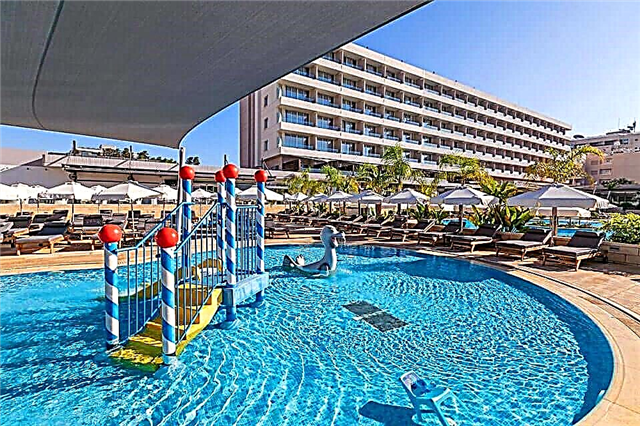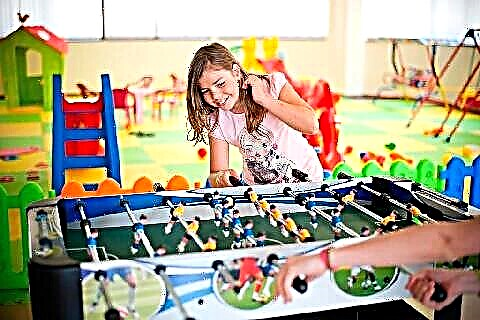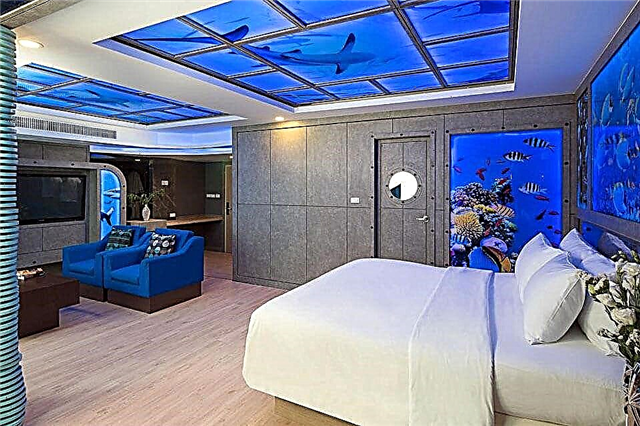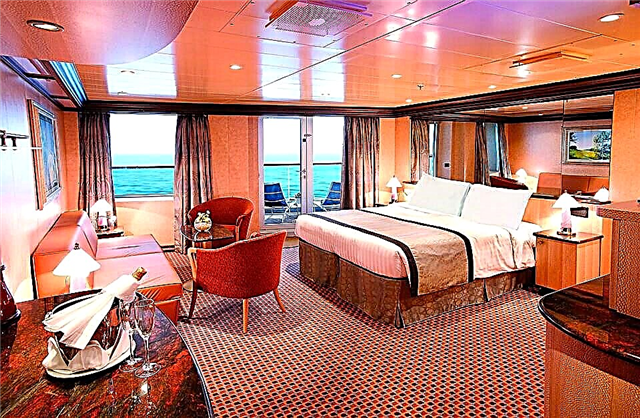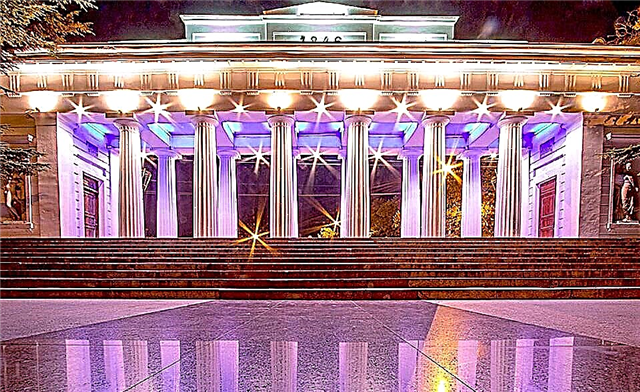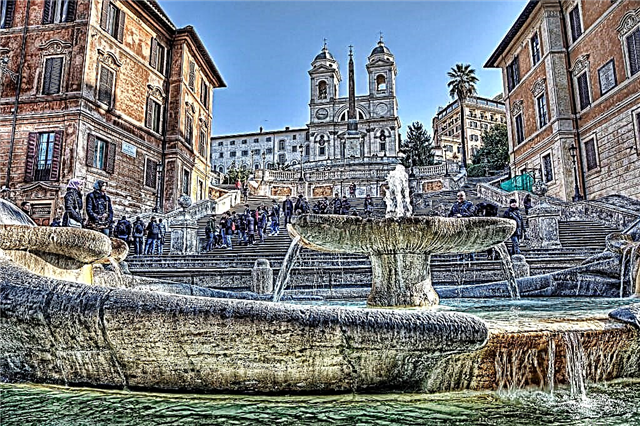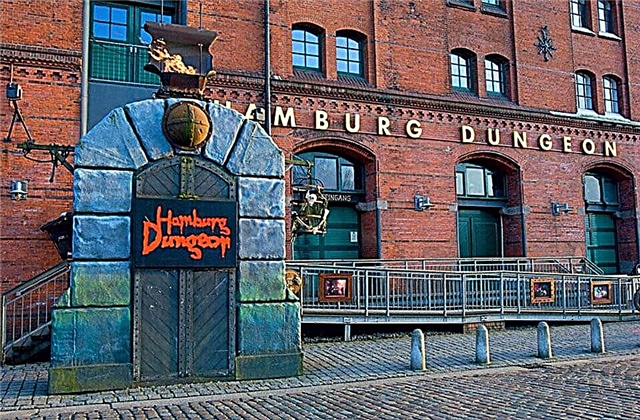Hamburg can in some way be called a special case, since this city has an extremely cozy, soft atmosphere of those very kind German cities from the romantic Middle Ages, but not the ever-jerky rhythm of a typical port city, although it stands practically on the water - a kind of German Venice. It is worthy of admiration for its architectural delights, and the rich greenery of local parks and the luxury of cultural life. Let's talk about the most popular sights of Hamburg.
Gallery Kunsthalle

Masters Bertram and Franke - the thirteenth and fourteenth centuries, ancient engravings - the silhouettes of the "Dark Ages" of the Middle Ages, the colorfulness of the dynamism of the moment - the brushes of the impressionists of the nineteenth century, experimental samples of the era of modernism - a century that has passed quite recently - and these parallel ones intersect on the site of ancient fortress walls, swimming in the sunlight, in the brightness of the glare of the rushing Alster stream, in the rattling noise of the railway - they are crossed by the three buildings of the Kunsthalle gallery smoothly flowing into one another.
The modern gallery is akin to a pastry shop somewhere in the center of Paris - the windows are lit with lights, and the counters are going to collapse with a solemn creak from the abundance of steamed dough, cream fillings and chocolate splashes. So here too - behind the walls of light shell rock, behind the seemingly ancient colonnade, under a high dome - Munch, Toulouse-Lautrec and Runge, drinking tea sweetly - wildly unlike in their artistic manner. And there are thousands of such impromptu "tea parties" - how not to visit at least a few of them?
The Kunsthalle gallery gathers dust behind closed doors only on Mondays, on the other days it is ready to be filled with the clatter of steps and overflows of admiring exclamations, starting at ten in the morning. But with the closure of the gallery, everything is somewhat more complicated - as a rule, it finishes its work by six o'clock, however, on holidays, as well as on Thursdays, the “closed” sign turns up turned upside down only at nine o'clock in the afternoon. Of course, a visit to the Kunsthalle will arouse more interest among adults - a ticket costs twelve euros, but special conditions apply for children, for example, if a child is under seven years old, then the entrance for him will be free.
Johannes Brahms Museum

The tall Baroque building can be considered one of the most ideal variations on the theme of German classical architectural traditions, with its snow-white window frames, which even stand out too clearly against the dark brick background, with rich stucco columns standing guard at the main entrance, with its stained glass improvisations made of glass, kept in muted greenish tones.
In this tall building lived his life - albeit occasionally - a man who never submitted to the flow of his time with his love of operas - Johannes Brahms. Today, the house, in whose glass the childishness and spontaneity of this person was reflected, has turned into a museum, where everything, one way or another, screams about its belonging to this person - crooked peaks of notes, memoirs and notes, whole monographs dedicated to Brahms, and, of course, his music, however, is already recorded on disk media.
You can get to the Brahms Museum using the metro, and the first three branches are suitable, which will correspond to the following stations in sequence: "Stefanplatz", "Messehalen", "St. Pauli". Entrance to the museum is free for children and adolescents under the age of fourteen, but the museum will be glad to see everyone else from ten in the morning to five in the afternoon for a symbolic fee - five euros - on any day except Monday.
Falkenstein Puppet Museum

For museums where dolls or puppets constantly live, a completely magical atmosphere is characteristic, not without, however, a few frightening notes - some of the exhibits are even too believable or charismatic, which is especially felt in the dollhouse Prague, too, but Hamburg does not lag behind this city - scenes offering your own doll house.
In the Falkenstein Museum, dolls are collected, but not according to the principle of their high cost or age, but according to their belonging to the time period. Within the walls of a small villa, located in the silence of the local park of Sven-Simon, samples of the puppet world of the last three centuries are collected, more than clearly demonstrating the changes that have been subject to the standards of beauty of each individual passage of time. At the same time, the dolls do not gather dust behind glass bells, but live their lives in small sketch rooms, where real buildings and premises of the corresponding eras are reconstructed with amazing accuracy and detail.
You can get to the museum by bus or by personal car. For the first case, buses No. 189 and 286 are suitable - both of them stop at the S-Bahn station - Blankenese, where the museum itself is located. Visitors can only stroll through the Falkenstein Halls during very tight hours - from eleven in the morning to five in the afternoon from Tuesday to Sunday. At the same time, the ticket price varies from three to five euros.
Alster lake

Each ancient city has its own light - giant emerald patches that stand out among the grayness of buildings made of glass and concrete, but many also have their own arteries, which, if squeezed in a certain time interval, could lose the mentioned echo of antiquity. In Hamburg, such an artery was the Alster lake, which appeared after the installation of a dam on one of the tributaries of the Elbe.
Gumburzhians, like no one else, understand the value of this man-made reservoir - the Alster, for its almost eight-century history, has never fallen victim to irrepressible human enthusiasm and striving for progress - waste was not dumped into its waters, its shores were not taken for the cultivation of new lands. Instead, the richest parks were laid out in the vicinity of the lake, and the lake itself continues to be carefully cleaned and protected.
Of particular interest, perhaps, are the boat trips on the lake. Tiny powerboats, rowing boats and ferries circulate through the Alster, offering a little closer look at the familiar city sights, but already from such an "above-water" angle. Usually the price of such walks varies from ten to fifteen euros. In recent years, a new item has been added to the program of such tours - a statue of a girl with a graceful figure of a young bather, which was installed in the center of the lake. The four-meter guest quickly became "one of our own", almost immediately falling in love with both locals and guests who also do not mind relaxing on the shore with the aquamarine of the sparkling Alster.
Museum of Arts and Crafts

The city is home to one of the most complete collections in the world at the moment, incorporating exhibits illustrating the life of people, from the dawn of human civilization to modern times, as well as material evidence of cultural changes in man and his environment. The Museum of Arts and Crafts is truly universal, which can be easily traced to the example of those halls that are dedicated to the development of fashion trends.
They begin here with garments from the brilliant Egyptian tombs, smoothly moving on to samples of the Chinese silk industry, Flemish lace, the art of French tapestries, and even to samples of modern conceptualism, for example, to the works of Issei Miyaki. And similar more than complete collections can be called in relation to almost every component of a person's life, for example, the recently opened exhibition of keyboard instruments.The museum itself is located in a three-story building that most of all resembles a castle, made in accordance with the high requirements of classicism.
The easiest way to get to it is using the metro, since this type of movement - in this case - will exclude the possibility of getting lost or not finding the station you need, since you can get to the Museum of Art and Crafts by any of the branches. The main thing is not to miss one of the stations: Hauptbahnhof Sud or Hauptbahnhof Nord. It is better to get acquainted with the timetable of the museum on the official website, as this timetable is very flexible. But the prices for visiting are more than stable - twelve euros for adults and free access for those people who have not crossed the threshold of eighteen.
Gallery of contemporary art

The Kunsthalle Gallery has been holding the position of the main German concentration of classical culture for quite some time, starting from the early Middle Ages and right up to the flared up new era in art. But the percentage of really scandalous and contradictory from the point of view of significance and even the possibility of being classified as art, in principle, samples are not so great here. The situation changes dramatically when it comes to the gallery of modern art, which gradually separated from the Kunsthalle gallery itself, turning from a subsidiary into an independent one and moving into a separate building in the style of constructivism - a huge light cube.
The gallery of modern art contains both paintings and sculptures that belong to the eras of modernism and postmodernism in all their many-sided splendor and horror, the twenty-first century presented the gallery with installations as a new manifestation of art. Due to the deliberately avant-garde focus of this gallery, its expositions may not appeal to all guests of this place, so you should first learn a little more about the exhibits, so as not to experience disappointment.
The main landmark for walking to the gallery is the Lombardbrücke bridge, which is an iconic building of the Old Town. Alternatively, take the metro and continue to Hauptbahnhof Nord station. The gallery is open to the public on Tuesdays, Wednesdays and Fridays until 6 pm and until 9 am on Thursdays. The standard ticket price is twelve euros.
Hamburg History Museum

The beginning of the twentieth century was marked for Gambrug by large-scale destruction of old buildings, which prevented the construction of a free harbor. At the same time, they decided to reuse the bricks of the destroyed houses, but already for the construction of a building, which today occupies one of the largest interactive museums in the history of Hamburg, which contains collections designed to illuminate all the brightest, bloody and in some cases almost mystical pages from the history of the city - from a small fortress to the largest port city.
A visit to the museum will not become a boring duty, if only due to the fact that most of its exhibits can be touched or even tried on for yourself - what are some pirate ships and reconstructions of everyday life of the old port! Another plus for the guests of the museum is the opportunity to take a photo as a souvenir quite "legally", which is usually prohibited in most serious institutions of this profile. True, you still have to take pictures without a flash.
The bus number 112 goes to the museum, which makes a stop at the station of the same name. The museum is closed on Mondays, and on weekdays and Saturdays it is open until five o'clock, while on Sunday one more hour is added to visit. Tickets usually cost up to nine euros, which is more than acceptable.
Cap San Diego Museum

The graceful shapes and whiteness of cargo ships, left only in historical memory, personify the "Cap San Diego", a ship that spent nineteen years traveling from Germany to South America, and then anchored in Hamburg to become one of the most magnificent floating museums. As you might guess, most of its exposition refers specifically to navigation, although it is the "Cap San Diego" that is the main exhibit. The guests of the ship are invited to personally see its work from the inside and even take part in it.
Today the ship is used not only for such purely excursion purposes. Twice - sometimes three times - a year it goes to sea with half a thousand people on board, and also regularly becomes a platform for celebrations. At the same time, the minimum rental cost will be more than two hundred euros. A simple boat tour will cost a maximum of seven euros, while the "Cap San Diego" is open to the public all days of the week. The opening usually takes place at ten o'clock in the morning, the closing - at six noon. It will be quite difficult not to find the floating museum, as it is permanently moored at Landungsbrücken pier, which belongs to the third terminal of the port of Huberseebrück.
Opera theatre

The opera house, where, however, you can also see ballet performances, from the very moment of its foundation, was somewhat out of the category of similar institutions, since it highly valued its independence, and did not turn into a court theater, whose profile would largely depend on the whims of the court nobility ... Instead, the opera house has become public, becoming something akin to a bright fireworks display in the life of the hometown.
Unfortunately, the modern theater was unable to preserve its original building - the first wooden theater premises were barbarously burned down, and the new building marked by the production of Goethe's "Egmont" fell victim to an "accidentally" thrown bomb during the Second World War. It took the opera house about ten years to fully recover, but in the end it again occupied its rightful niche in the cultural space of Germany.
The theater's repertoire is varied, and the prices for its visits are also varied - it all depends on the nature of the production and the cast involved in this production, although it is also impossible to call these prices too high. Usually tickets can be purchased starting from eleven euros, although these will not be the best seats. The troupe is really working hard as the theater is open all year round. You can get there by bus. Those stopping at the Stephansplatz station are suitable - numbers 603, 112, 109, 36, 34, 5 and 4, respectively.
Botanical Garden

Surprisingly, a whole botanical garden has grown on the site of a rather small pharmaceutical garden. True, this did not happen in one moment - it took more than a century and the special port status of Hamburg to turn the pharmaceutical garden into just one of the many flowering and fragrant components of the huge botanical garden.
The botanical garden is traditionally divided into North and South, which are also subdivided thematically. For example, the Japanese Garden is still considered the real pride of the garden, which presents all the necessary elements of the classic idea of this place with three spruces, among whose branches bells, gazebos, traditional stone paths, splashing water and soft unobtrusive colors are confused. Every corner of the world represented in the Botanical Gardens has been reproduced with great detail and trepidation.
Admission is free, making it an extremely popular destination for walks and a variety of cultural events. At the same time, a quiet walk in the garden can be enjoyed both early in the morning and quite late in the evening - it is open from seven in the morning until eleven in the afternoon. You can also get there by metro - a trip to St. Pauli station, and by bus - numbers 112 and 688 to the Handwerkskammer stop.
Museum of Erotic Art

One of the most complete collections of art objects, one way or another related to the sexual and erotic aspects of human life, is located in the Museum of Erotic Art.The exposition of the museum appeared thanks to the initiative of a private person and very quickly was replenished with numerous exhibits of different eras and styles.
Here you can find unique, from a cultural point of view, woodcuts, lithographs, images on silk that came from the Land of the Rising Sun (the oldest of them date back to the sixteenth century), as well as examples of European culture - free Parisian baroque, classics Western European Art Nouveau, the brightness and ambiguity of the colors of postmodernism. The location of the museum is also extremely well chosen - on one of the busiest streets - on the Reeperbahn, which is known for its free entertainment profile and the first experiments of the Beatles.
The Museum of Erotic Art, as well as a related profile bookshop, are open all year round. The opening hours are shifted in favor of the afternoon - the museum opens after twelve and is ready to receive guests for the next ten hours from Sunday to Tuesday, or twelve hours on the remaining days. Ticket prices are also quite loyal - they rarely exceed eight euros.
Zoo museum

The exposition of the modern zoological museum, located in Hamburg, is based on more than rich collections of the former naturalistic museum, which was established in the first half of the nineteenth century. Unfortunately, some of the exhibits were destroyed along with the original building during the period of enemy bombing, but the remaining samples were enough for the museum not to frighten its guests with empty showcases. Moreover, it is quite difficult to drive some guests of the modern museum away from the aforementioned showcases, since the zoological museum contains fossilized, alcoholized and reconstructed remains of various animal species, starting from the era of dinosaurs.
It only takes enthusiasm to visit this museum, since the entrance is completely free from ten o'clock until five in the evening. The only exceptions are Sundays and the days of really significant holidays when the museum is closed. You can get to the museum using the metro. The closest station is called Schlump, and an additional ten minutes will have to be spent on the road from the metro exit to the building itself.
Hagenbeck Zoo

The zoo is named after the German scientist and wildlife collector Karl Hagenbeck. The entrepreneur went down in history as the author of the idea of keeping representatives of the animal world not in cages, but in open-air cages, where living conditions close to natural ones were created. Hagenbeck was born in Hamburg and founded a menagerie here, which later received the status of a zoo. The institution was opened to the public in 1907. Today it belongs to the descendants of the scientist and functions at the expense of private donations.
The Hagenbeck family continues to improve the zoo founder's designs and contribute to the conservation of endangered wildlife. The establishment covers an area of about 25 hectares, the length of its pedestrian zone: 7 kilometers. On the territory of the zoo there are over 16 thousand individuals: animals, birds, fish, reptiles. One of the main attractions of the institution: a huge tropical aquarium installed at the entrance. A separate section of the zoo is dedicated to ... dinosaurs.
The fact that they became extinct millions of years ago did not become an obstacle for Karl Hagenbeck: the life-size sculptures of prehistoric animals made at his order look very realistic. About 1.7 million tourists visit the zoo annually. Guests of all ages are attracted by the opportunity to participate in the daily wildlife feeding show. On the territory of the zoo there are cafes, attractions for children, souvenir shops.
Church of St. Nicholas

The ruins of the Church of St. Nicholas are a monument to the inhabitants of the city who died after the National Socialists came to power in Germany in the 30s of the last century and during the Second World War. In 1943, the air forces of the United States and Great Britain subjected Hamburg (where the military-industrial, strategic enterprises were located) "carpet bombing". The city turned into a fire trap: the asphalt was burning, a hot storm wind, which arose due to temperature changes, raged on the surface. During these days (according to official data) 50 thousand people died and 200 thousand were injured, about a million townspeople were homeless.
During Operation Gomorrah (named by the British military in honor of the Old Testament city, destroyed by fire falling from the sky), over 70% of buildings were destroyed, including the Lutheran Church of St. Nicholas. Years later, the city was reborn from ruins, and the surviving neo-Gothic tower of the church, mournful sculptures at its foot, bell ringing on memorial days remind of the dead. There is a museum dedicated to the temple not far from the building. The Church of St. Nicholas dates back to the 11th century.
Its first construction was wooden; in the XIV century, the townspeople erected a stone temple on the site of the building. It suffered in the 19th century when a fire that broke out destroyed over 1,700 houses. 32 years after those events, the newly built church began service, whose splendor can be judged by the tower of the memorial of St. Nicholas. 2 years after its construction, the temple was the tallest building in the world. The height of its surviving tower: 147 meters. Today, under its spire, there is an observation platform, where tourists and Hamburgers take an elevator to admire the city from a bird's eye view.
St. Michael's Church

The Protestant temple, in whose architecture the canons of Baroque and Classicism are intertwined, is called one of the city's visiting cards. Many Christian denominations consider the Archangel Michael the patron saint of sailors. Is not the only port in the world where a temple was erected in his honor. The fate of the church in the German city can hardly be called happy, but the construction survived during the Second World War ... The first building of the temple was erected in the 17th century, later it was struck by lightning, causing a fire. The construction of the temple began again. When the bell tower was completed, a fire broke out.
The walls of the church survived, and the tower collapsed. Local authorities were categorically against the restoration of the building, but the townspeople demanded to build it according to the old drawings. A compromise was found: the church was erected in 1912, focusing on the previous project, but reinforced concrete was used for it. The height of the new church bell tower, where the largest clock in Germany operates, is 132 meters. Later, an observation platform was equipped here, which can be reached by stairs (where there are more than 400 steps) or by elevator.
A bronze statue of the Archangel Michael was erected near the entrance to the temple. The main relic of the church: the altar 20 meters high, created of white marble, still amazes with its splendor. The temple is the place where the ashes of two great German composers rest: Johann Matteson (his opera about Boris Godunov became the first European work on the theme of Russian history) and Bach's son, Karl Philip Emmanuel (one of the founders of the classical style in music).
Church of St. Catherine

The building of the Protestant temple is one of the oldest in the city. It went down in the history of music: in this church, Johann Sebastian Bach played his works on the organ. The first mention of the Church of St. Catherine in historical sources occurs in the XIII century. 200 years later, a new building was erected in its place. The temple was often rebuilt, but the architects managed to give it a harmonious look. The church is located on the site of a shallow groundwater table.
To preserve the building under the foundation, a "cushion" of 1100 larch logs is provided. Wood is not afraid of water - it only makes it stronger. This design of the church is very symbolic, because the structure was erected by sailors and shipbuilders.During the Second World War, the bell tower was destroyed, a fire that broke out after a bomb hit destroyed most of the relics. To raise funds for the restoration of the temple, parishioners sold their land plots.
By 1956, the church and bell tower 115 meters high were reconstructed, and a year later, luxurious stained glass windows created by modern craftsmen adorned the temple windows. Since the 60s of the last century, the church has been reopened to the public. In its building you can see several statues of St. Catherine made in the 15th and 17th centuries, two unique medieval altar paintings depicting Christ.
Church of St. Jacob

The grave of the Apostle James, according to the legends and testimonies of the miraculous acquisition of relics recorded in church chronicles, is located in Spain. To worship the shrine, pilgrims from all over Europe set off along the pilgrim road named after the disciple of Christ. Throughout it, churches and monasteries were erected in different states, where tired wanderers found shelter. The Chapel of St. James (Jacob) was among such structures.
The temple in its place was erected in the XIV century. In some sources, the 15th century is indicated as the time of its opening due to the fact that the layout and appearance of the building were changed several times over the century. During the Napoleonic Wars, the French converted the Lutheran temple into a stable and destroyed most of the relics. The parishioners managed to restore the church, but during the Second World War it was destroyed. By 1962, the building was rebuilt according to the surviving old drawings.
The only thing: changes were made to the shape and design of its spire. The main treasure of the temple today is its medieval altars in honor of the Holy Trinity, the apostles Peter and Luke. The church has an organ played by Johann Sebastian Bach. There is a cafe in the temple bell tower at an altitude of 84 meters, whose profits go to charity.
The Beatles Square

The round square, 29 meters in diameter, looks like a vinyl record. The Beatles-Platz are equipped with metal figures of the members of the legendary band. Funding for the construction of a new facility (like much that is associated with the Beatles) has not been without scandals. Initially, the authorities planned to spend 100 thousand euros on the creation of the area and build it in 2 years. The cost of materials and work increased 5 times due to the fact that according to the results of the competition, the project for the construction of Beatles-Platz was chosen in 3 months.
There were no such funds in the city treasury - the situation was saved by private donations. The square was opened in 2008. Fortunately for the local authorities, the band members did not attend the ceremony. On the commemorative plaques with the names of the songs of the Liverpool quartet "flaunted" gross spelling errors. The builders then corrected the latter, and the scandal continued to gain momentum ... Oil was added to the fire by the fact that 4 figures were captured on the square, and in Hamburg in the 60s for 2 years, 5 people performed as part of the group.
The Beatles in the city's nightclubs worked illegally. Pete Best and Paul McCartney were involved in a criminal conflict: they were charged with arson. The musicians were deported from Germany, which did not prevent them from returning to Hamburg and continuing their performances soon. All these details only add interest to the square - a favorite place for selfies of Beatles. The museum located next to it was less fortunate: it worked for 3 years and was closed due to unprofitability.
Tchaikovsky House

The spiritual and educational center of the same name belongs to the Russian Orthodox Church. The community that built the building was formed at the beginning of this century and is under the jurisdiction of the Moscow Patriarchate. The Tchaikovsky House has one of the best Russian-language libraries in Germany and a computer class for learning the Russian language. Tchaikovsky Square is located next to the building. The great composer repeatedly visited Hamburg, admired the works of his German colleagues, and loved sacred music.
Pyotr Ilyich Tchaikovsky was friends with Johannes Brahms. It is symbolic: the squares named after geniuses are located nearby in the city. The main part of the Tchaikovsky House is occupied by the hall of the same name with 160 seats. The concert venue regularly hosts charity concerts of classical music, festivals, creative meetings with the participation of world stars, screenings of documentaries, exhibitions, master classes. The Spiritual and Educational Center is funded by Russian and German sponsorship donations.
Hamburg dungeon

Hamburg Dungeon is popular with nerve-tickling enthusiasts. On the territory of the museum there are 2 attractions, where the horrors of the port city come to life with the help of modern technology and great acting. It is noteworthy: these are quite real nightmares that residents have faced for centuries.
Museum guests become participants in an interactive show, plunge into the dark atmosphere of the city's criminal past and natural disasters. At the moment, the institution has 11 entertainment programs, including those designed for schoolchildren. The organizers of the show believe that such attractions awaken the interest of the younger generation to the real story. Museum visitors can learn a lot about the life of smugglers and the everyday life of the Inquisition.
The building is equipped with an exact copy of the torture chamber. Separate museum expositions are dedicated to the pirate raid, plague epidemics, fire, flood, Napoleonic invasion. The Executioner, the Judge, the Plague Doctor live in the dungeon. It also has its own White Lady - a popular character in legends about dungeons in different parts of the world. The duration of each excursion program is 90 minutes. The museum is open every day except for Christmas Day.
Chilehouse

A warehouse building with a height of 11 floors was erected in the 20s of the last century. It was built in the style of expressionism, but its decor reflects the motives of eclecticism, gothic, rationalism. For the exterior decoration of the building, local materials and technologies traditional for Germany were used. Outwardly "Chilehouse" resembles a ship. The house is an example of how a commercial object can be successfully located on a narrow long plot of land. Soon after commissioning, the building was recognized as a masterpiece and one of the city's calling cards.
It got its name in honor of Chile. Property owner Henry Sloman - the owner of a shipping company, one of the richest residents of Hamburg at the beginning of the 20th century - spent more than 30 years in Latin America, where he made a fortune. Later "Chilehaus" became the property of his descendants. The maintenance of the house required significant financial investments, the heirs of Sloman were unable to solve this problem. Today Chilehaus is under the protection of the state, which takes care of the restoration and preservation of the historical appearance of the building, included in the list of UNESCO World Heritage Sites.
Museum of Wax Figures "Panopticon"

The institution is considered the oldest wax museum in Germany. It was opened to the public in 1879. Since that time, the private museum has gained the fame of the institution, where expositions are devoted to topical topics and issues, including embezzlement. In the 19th century, in its halls one could see wax figures of fined city officials and burgomasters, criminals and scandalous celebrities of the half-world.
Centuries later, "Panopticon" to a certain extent remained faithful to tradition: its collection is periodically replenished with sculptures of odious personalities. For example: the figure of the eco-activist Greta Thunberg recently appeared here. After World War II, 19 remained of the unique museum collection of 140 sculptures. It took 5 years to restore the collection.In the renovated museum, there was a place for wax figures of representatives of warring political camps (supporters of Hitler and heads of state of the anti-Hitler coalition), athletes, famous cultural figures.
Modern sculptures differ significantly from the first exhibits in materials and manufacturing technologies. Today, doubles of famous personalities move, “talk”. On average, the purchase of each sculpture costs the museum 18-20 thousand euros. He is proud of the figures of Romy Schneider, Charlie Chaplin, Freddie Quinn, Udo Jurgens, Johann Wolfgang Goethe, Michael Jackson.
Museum-ship "Rikmer Rikmers"

The majestic three-sail ship museum recalls the times when goods were transported between continents on such ships. Many tourists and residents associate it with the romance of distant wanderings. The vessel, whose length is 97 meters, has its history since the end of the 19th century. Initially, it was intended for flights to the states of the East and back, then Great Britain and Latin America were added to the map of its routes. The sailboat carried rice, bamboo, coal, saltpeter.
The end of the ship's service life was not the reason for its dismantling. On the contrary: the ship was restored, changes were made to its design, engines were installed, and sailing characteristics were improved. In 1987, a museum was opened here, where authentic items of everyday life of sailors, models of ships, historical relics are presented. The Rikmer Rikmers Gallery regularly hosts exhibitions of marine painters. There is a restaurant on the ship, whose menu includes interesting seafood dishes. The most popular pastime among visitors to the ship: climbing to the top of its 35-meter mast for an overview of the surroundings.
Miniature wonderland
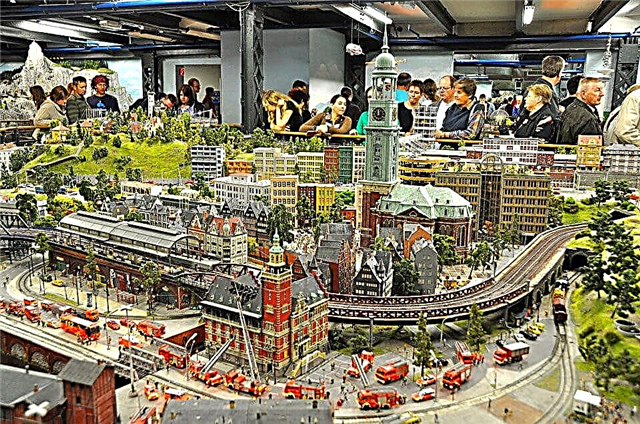
The museum is one of the clearest proofs of the fact that commercially successful projects often originate in the childhood dreams of their creators. The story of the emergence of the "Miniature Wonderland" is like a fairy tale ... At the beginning of this century, the Brown twin brothers decided to open a private museum, which will be the largest operating model of the railway in the world. Frederick and Gerrit drew up a business plan, sent loan applications to various banks.
The people around them were skeptical about the twins' project. However, a miracle happened: one of the banks provided a loan. The museum created by them in the first year of operation paid off the funds invested in its opening. Nowadays, the staff of this amazing institution is about 300 people. "Miniature Wonderland" consists of 10 sections, one of which is dedicated to Hamburg. The area of the city model is 200 square meters. There are 190 trains on the railways of miniature Hamburg, and 1,300 cars on the highways.
The total length of the museum's railway tracks (taking into account all 10 sections): over 15 thousand meters. More than a thousand trains and 9 thousand cars move along its roads. The models contain over 4 thousand copies of buildings, about 260 thousand figures of people and animals, about 130 thousand miniature trees. Each section is interesting in its own way. To plunge into the atmosphere of Austria, USA, Switzerland, Scandinavia, various parts of Germany, Italy, it is enough to visit an amazing museum, where the day is also tiny: they last only half an hour (15 minutes a day and the same night).
Elbe Philharmonic

The history of the construction of the 26-storey building is associated with a number of scandals, but this particular concert hall is one of the top popular European attractions and is recognized as an ingenious architectural creation. The construction of the Philharmonic Society lasted about 10 years, it was completed in 2017. The opening of the facility was repeatedly postponed. During this time, the cost of materials and work has increased 3 times. Over 780 million euros were spent on the construction. Have the costs paid off or not?
A controversial issue, however, the building transformed the territory of the old port, attracted public attention to the problem of rational use of old structures and areas inconvenient for construction. Today the Philharmonic is a cultural and residential center with two concert halls for 2,100 and 550 spectators, shops and apartments. The infrastructure of the building includes a restaurant and a cafe, as well as a popular five-star hotel.
Outwardly, the Philharmonic Hall resembles a fabulous giant crystal. The facade of the futuristic building is decorated with glass panels that reflect the sky and water. Its foundation: a warehouse built in 1963. The simplicity, laconicism of the lower part of the building further emphasizes the splendor of the superstructure. Total height of the building: 110 meters. To admire the city and the harbor from the observation deck of the Philharmonic, it is enough to climb the escalator to the 8th floor, where free access is open.
Museum-submarine B-515

The Soviet submarine is both a museum and a unique exhibit located not far from the city's fish market. It also has another name: U434 (it is mostly indicated in German travel guides). The diesel-electric submarine was launched in 1976 in the Soviet Union. After 19 years, the service life of the vessel ended. The military did not modernize the submarine and wrote it off. At that time, she was in the port. German entrepreneurs bought the B-515 and equipped one of the most popular private museums in Germany and Europe on it.
The new owners of the ship recreated inside it the atmosphere that prevailed on Soviet submarines. The uniform on the models of the military is genuine (like all insignia). The limited space inside the cockpits literally crushes and allows one to feel in the place of the people who served here. Most of the items on the ship are authentic. Some of them were acquired by the organizers of the museum at flea markets, which led to incidents. For example: among the exhibits there are things that belonged to the military personnel of Ukraine. On board a submarine created for warfare, visitors to the museum come into contact with the world of Soviet submariners, previously closed from prying eyes.
International Maritime Museum

The organization of the museum was supported at the state level; the first persons of the German government took part in the opening ceremony in 2008. The building of the port warehouse, where unique collections are located, is striking in its scale and grandeur. Its austere architecture creates the impression that an impregnable castle-ship is frozen on the water surface. Consists of 9 themed decks designed for adults and children. There are halls dedicated to the history of shipbuilding, models of small ships, great geographical discoveries, sea treasures, and works of art.
Peter Tamm (the founder of the museum) joked: his unique collection lacks only items from Noah's Ark, the rest is sure to be found. An amazing man with a sea soul, he devoted many years to journalism and publishing. He gave the collected collection to the city. One of the five sons of Tamm today heads the institution and continues the work started by his father. The value of the museum funds today exceeds 100 million euros.
The main relic of the establishment is ... a children's toy: a small tin ship. It symbolizes something that is higher than any money and jewelry: this is a mother's gift to six-year-old Peter. Later, it was with such a simple thing that the work of his whole life began. In his youth, Peter dreamed of becoming an admiral and as a result achieved more: he carried out a grandiose international project to create a fleet of miniature ships belonging to all historical eras.
Chocoversum Chocolate Museum

The institution is called a paradise for gourmets and shopaholics. Here you can learn literally everything about the secrets of making chocolate, the beneficial properties of cocoa beans, and get acquainted with the history of confectionery production.A special atmosphere of happiness reigns within the walls of the museum, which is quite natural, because a delicacy can improve your mood. Scientifically proven fact: chocolate relieves depressive conditions, increases vitality, improves the well-being of children and adults.
Initiator of the opening and owner of the museum: the German factory "Hachez". Its main production and head office are located in another city - Bremen. This is not the first Hachez museum in Germany, but the Hamburg establishment (opened in 2012) is considered one of the most popular among tourists. The factory that founded Chocoversum dates back to the end of the 19th century. Traditions of German and Belgian chocolatiers, confectionery production technologies are quite similar.
This is quite natural, because specialists from Belgium were at the origins of the German food industry. Excursion programs in the museum are designed for 90 minutes, the institution is open seven days a week. After visiting the exposition, tasting, naturally, there is a desire to buy "chocolate gold". Next to the museum there is a store "Hachez", in which the assortment of small curly chocolates, and huge large assorted sets.
Automobile Museum "Prototype"

Those who consider auto business to be exclusively a traditional male occupation are fundamentally mistaken. The number of auto-ladies among museum visitors is growing every year. Most of the exhibits of the unique collection exist in single copies. The pride of the museum is a racing car driven by Mikhail Schumacher. Tastes are different: some love classical music, others enjoy the roar of car engines.
The latter sound completely different, as the visitors of the exhibition can see for themselves. The basis of the collection, designed for a target audience of different ages, is made up of 50 racing cars manufactured in the last century. All of them are located in the building where the factory used to be. There is a specialized shop nearby where you can buy miniature copies of your favorite cars. A workshop for the restoration of equipment is located in the museum building itself.
It is separated from the exhibition halls by transparent glass, which allows you to see the painstaking work of specialists. The institution provides a cinema. The building also houses an exposition of vehicles created in different epochs of human development. It includes sledges, motorcycles, boats. For those who dream of being behind the wheel of the first famous rear-engined sports car, Porsche, the museum organizers provide this opportunity. One of the premises of the building is equipped with a racing stimulator created from original parts of the car.
Stadtpark

Residents perceive parks not only as useful recreational areas: for city residents, they are sources of joy, vitality, and inspiration. The city center and Stadtpark are separated by 3 kilometers, but it was the latter that received the nickname "the green heart of Hamburg". The history of the park dates back to 1914. Public and private gardens often turn into huge recreational areas in Europe. This also happened with the Stadtpark, whose area today is 148 hectares.
Initially, the park was designed for representatives of all walks of life. Then it seemed like a revolutionary innovation. The emergence of a recreational zone around the lake opened access to quality rest for the townspeople who did not have the opportunity to travel abroad, travel, visit resorts. The park was rebuilt in the pre-war and post-war times. For ideological reasons, some of the sculptures were dismantled and then ... returned to their original places. To our time, 22 figures have survived, installed before the Second World War. They are located in different parts of the Stadtpark.
Some of them are part of the fountains, others are in playgrounds or surrounded by flower beds. The largest German planetarium operates on the territory of the park (located in the building of a water tower, whose height is 64 meters). Sports grounds, two stadiums, a concert stage, a swimming pool, a chess square, a rose garden are created in different architectural styles, but together with other park objects they form a harmonious architectural ensemble. The Stadtpark is open to the public all year round and is free to enter.


